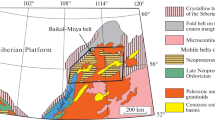Abstract
The Salsigne gold deposit contains a complex association of sulphide layers, gold-rich disseminations, quartz-bearing veins and flat reefs, which are hosted by folded and slightly metamorphosed Paleozoic sediments on both sides of a major thrust zone. It is demonstrated that these various Au-As ore types have similar lead-isotope compositions (206Pb/204Pb = 18.22–18.56), which are characteristic of Hercynian ore deposits in the southern Massif Central. The Lower Cambrian to Devonian host rocks and associated Pb-Zn-Ba occurrences display distinctly less radiogenic corrected isotopic signatures (206Pb/204Pb = 17.83–17.98), which are characteristic of Cambrian lead in the Montagne-Noire. Concerning the controversial origin of the Salsigne gold mineralization, these results disagree with the former syngenetic hypothesis and support a new model of Hercynian syntectonic gold concentration.
Similar content being viewed by others
References
Bonnemaison, M., Crouzet, J., Thiercelin, F., Tollon, F. (1986) Controls on exhalative gold deposits hosted by volcaniclastic sediments in the “X Schistes”, Salsigne gold district, Montagne-Noire, Southern France. Proceedings of Gold '86 Symposium, Toronto, pp. 457–469
Brévart, O., Dupré, B., Allère, C.J. (1982) Metallogenic provinces and the remobilization process studied by lead-isotopes: lead-zinc ore deposits from the southern Massif Central, France. Econ. Geol. 77:564–575
Brévart, O. (1985) Les isotopes du plomb en métallogénie. Thèse Doct. ès-Sci., University of Paris VII
Crouzet, J., Tollon, F. (1980) Le gisement stratiforme et filonien de Salsigne, Aude. 26th International Geological Congress, Paris, gisements français, fasc. E8, 54 p.
Cumming, G.L., Richards, J.R. (1975) Ore lead-isotope ratios in a continuously changing earth. Earth Planet. Sci. Lett. 28:155–171
Demange, M., Issard, H., Perrin, M. (1986) Rapports entre la zone axiale de Montagne-Noire et les nappes du versant sud au sudouest du massif (Minervois et Cabardès, Aude, Hérault). Géologie de la France 3:281–292
Demange, M., Serment, R., Touil, A. (1990) Les altérations hydrothermales dans les minerais de type “grès riches” du gisement aurifère de Salsigne (Aude, France). C.R. Acad. Sci. Paris, V. 310, série II, pp. 1241–1246
Köppel, V. (1983) Summary of lead isotope data from ore deposits of the Eastern and Southern Alps: some metallogenic and geotectonic implications. In: Schneider, H.J. (ed.) Mineral Deposits of the Alps and of the alpine epoch in Europe. Springer, BerlinHeidelberg-New York, pp. 162–168
Leblanc, M. (1989) L'or du domaine varisque: un héritage CambroOrdovicien? C.R. Acad. Sci. Paris, v. 309, série II, pp. 569–573
Lépine, J., Ben Ayad, M., Béziat, D. (1988) Mise en évidence de métabasites alcalines Cambrien inférieur dans le district aurifère de Salsigne (versant sud de la Montagne-Noire). C.R. Acad. Sci. Paris, v. 306, série II, pp. 1087–1092
Lépine, J. (1989) Le gisement sulfoarsenié aurifère du Cambrien inférieur de la mine traditionnelle de Salsigne (Montagne-Noire, France). Thèse Doct., University Paul Sabatier, Toulouse, 243 p.
Lescuyer, J.L., Giot, D. (1987) Les minéralisations Pb-Zn de Montagne-Noire et leurs relations avec leur encaissant cambrien carbonaté sur quelques exemples du versant nord et du versant sud. Document BRGM no 120, 143 p. + apps.
Manhes, G., Minster, J.F., Allègre, C.J. (1978) Comparative uranium-thorium lead and rubidium-strontium study of the SaintSéverin amphotérite: consequences for early solar system chronology. Earth Planet. Sci. Lett. 39:14–24
Marcoux, E. (1987) Isotopes du plomb et paragenèses métalliques, traceurs de l 'histoire des gîtes minéraux. Thèse. Doct. ès-Sci., University of Clermont II, and Document BRGM no 117–287 p. + apps.
Michard-Vitrac, A., Albarède, F., Allègre, C.J. (1981) Lead-isotopic composition of Hercynian granitic K-feldspars constrains continental genesis. Nature 291:461–464
Ostic, R.G., Russel, R.D., Sandstone, R.L. (1987) Additional measurements of the isotopic composition of lead from stratiform deposits. Can. J. Earth Sci 4:245–269
Reynolds, D.G. (1965) Geology and mineralization of the Salsigne Gold Mine, France. Econ. Geol. 60:772–791
Routhier, P. (1963) Les gisements métallifères — Géologie et principes de recherches. Masson, Paris, 2 volumes, 1282 p.
Stacey, J.S., Kramers, J.D. (1975) Approximation of terrestrial leadisotope evolution by a two stage model. Earth Planet. Sci. Lett. 26:207–221
Tollon, F. (1969) Le district aurifère de Salsigne (Aude). Thèse Doct. ès-Sci., University of Toulouse, 176 p.
Touray, J.C., Marcoux, E., Hubert, P., Proust, D. (1989) Hydrothermal processes and ore-forming fluids in the Le Bourneix gold deposit, Central France. Econ. Geol. 84:1328–1339
Author information
Authors and Affiliations
Additional information
This work was supported by BRGM'S scientific program: “Le gisement de Salsigne: caractérisation du modèle et évaluation du potentiel aurifère du district”
Rights and permissions
About this article
Cite this article
Le Guen, M., Lescuyer, J.L. & Marcoux, E. Lead-isotope evidence for a Hercynian origin of the Salsigne gold deposit (Southern Massif Central, France). Mineral. Deposita 27, 129–136 (1992). https://doi.org/10.1007/BF00197097
Received:
Accepted:
Issue Date:
DOI: https://doi.org/10.1007/BF00197097



